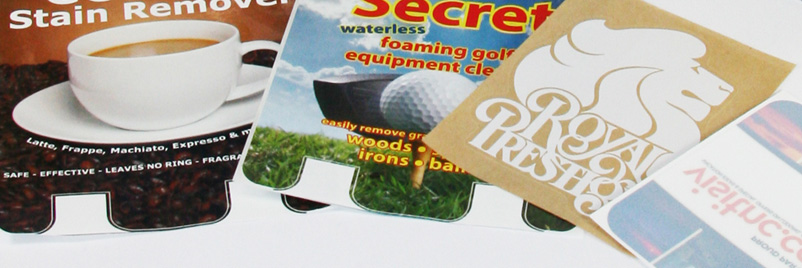
Visit our Blog and Subscribe!
As a wholesale supplier, we understand that our customers prefer to market our products with their own brand. To do so is simple:

ACCELERATED AGING
Subjecting pressure sensitive label material to special environmental conditions to predict the course of its natural aging.
ACETATES
Transparent and cellulose films used as label face material.
ADHESIVE
A substance that holds label materials together by surface attachment.
ADHESIVE, ACRYLIC
Pressure sensitive with high-strength, acrylic polymers.
ADHESIVE BLEED
Adhesive migration from pressure sensitive material and labels.
ADHESIVE, COLD TEMPERATURE
Adheres to refrigerated substrates (application range of -20° and service range of -65°).
ADHESIVE DEPOSIT/RESIDUE
The pressure sensitive adhesive remaining on a substrate when a label is removed.
ADHESIVE, DRY GUM
Adheres by getting it wet and then applying it to the substrate.
ADHESIVE, FREEZER TEMPERATURE
Adheres to freezer substrates (application range of 0° and service range of -65°).
ADHESIVE, HEAT SEAL
Has a coating that melts under heat to form a bond.
ADHESIVE, HIGH TEMPERATURE
Withstands sustained, high temperatures (+200º F or higher).
ADHESIVE, HOT MELT
Is applied to the release liner at an elevated temperature; cools into a conventional, tacky pressure sensitive adhesive.
ADHESIVE, OPAQUE
Is darkened so printing can’t show through the adhesive-coated side of a label.
ADHESIVE, PATTERN COATED
The spacing arrangement of adhesive areas on the face material. AKA dry lap, strip coated or zone coated adhesive.
ADHESIVE, PERMANENT
Has relatively high ultimate adhesion to many substrates.
ADHESIVE, PRESSURE SENSITIVE
In dry form it’s very tacky at room temperature, and bonds on contact with pressure.
ADHESIVE, REMOVABLE
Has low ultimate adhesion; removes from most substrates without damaging the surface or leaving adhesive residue.
ADHESIVE, RUBBER BASED
Is derived from natural or synthetic rubbers.
ADHESIVE SPLITTING
Portions of pressure sensitive adhesive remain on the face material and substrate when the label is tampered with or removed.
ADHESIVE STRIKE-THROUGH
When adhesive penetrates through the face material of a pressure sensitive lamination.
ADHESIVE, WATER-BASED
Is derived from water based materials.
ADHESIVE, WATER SOLUBLE
All components of this adhesive dissolve in water.
ANCHORAGE
The specific adhesion of a pressure sensitive material to a substrate.
ANCHOR COAT
Coating applied to the substrate to increase adhesion of other coatings.
ANVIL CUT LABELS
Are die cut through all components of the label stock, including the liner. AKA steel-to-steel, zero tolerance, punched out, or blanked out labels.
APPLICATION
Placing a label on a substrate. Also, how a label will be used or its life cycle.
APPLICATION TEMPERATURE
Temperature of label material when it’s applied; be sure to test minimum and maximum application temperatures.
APPLICATOR
Automatically feeds and applies pressure sensitive labels to a substrate or product.
BACKING
The sheet of material opposite a label’s face material. AKA release liner, backing paper and carrier.
BACK SPLITS
Linear cuts in the label’s liner.
BARRIER COAT
A coating applied to a face material on the side opposite the printing surface between the material and the adhesive coat.
BATTERY LABEL STOCK
A durable, acid-resistant label material for automotive batteries.
BLISTER
A bubble that forms from gas or fluid trapped under a label’s surface.
BLOCKING
When label sheets or rolls stick together, usually from cold flow, improper ink drying or improper curing of coatings and adhesives.
BLOWN-ON LABELS
Labels are removed from the carrier and applied to the substrate with air pressure.
BUTT-CUT LABELS
Rectangular labels in continuous form separated by a single cut in the liner. AKA kiss cut labels.
BUTT ROLL
A roll of pressure sensitive label stock that’s very short.
CARRIER
A paper or film for pressure sensitive labels.
CHEMICAL DRUM LABEL
A durable label material (vinyl or polyester) that resists the demands of chemical drum containers.
CLEAR COAT
A varnish and lacquer that protects the label’s surface from abrasion, sunlight, chemicals and/or moisture.
COHESIVE STRENGTH
Measures a label's resistance to removal.
COLD FLOW
When pressure sensitive adhesive steadily breaks down under stress.
COMPUTER IMPRINTABLE LABELS
Pre-printed or imprinted labels carrying variable information, such as a barcode and price.
CONTINUOUS LABELS
Fan-folded labels made from a continuous web of label stock that’s not cut into units before packaging.
CORE SIZE
The inside diameter of the (cardboard) core in a roll of labels.
COUPON BASE
The clear base in a dry peel label construction; usually used for instantly redeemable coupons. This base is combined with a face material and laminated. When the printed face material (or coupon) is removed, the clear base remains on the substrate.
DESTRUCTIBLE LABEL
This pressure sensitive label has a weak face material so that removing the label usually destroys it.
DRY PEEL
Labels bonded together with a dry adhesive. The top ply removes with no adhesive residue; the bottom ply is typically clear so the substrate can be seen through it. Commonly used for instantly redeemable coupons/promotions.
EDGE LIFT
The tendency of a label’s edge to rise off the substrate. Resistance to edge lift depends on the adhesive bond strength and the face material’s flexibility.
EXPOSURE TEMPERATURE
The temperature to which a label product is exposed.
FACE CUT LABEL
A die cut or square cut label from which the matrix, or waste between labels, has not been removed.
FACE MATERIAL
Any paper, film, fabric, foil or plastic material suitable for converting into pressure sensitive labels. In a finished construction, the face material is bonded to an adhesive layer and carried on a liner.
FACE SLIT
A slit in the face material of a pressure sensitive label so it can be removed from its backing.
FACE SPLIT
A linear cut in a label’s face material during coating or converting to meet special application requirements.
FAN-FOLDED LABELS
Are perforated, then folded back and forth along the perforations to create a flat pack.
FEED SLOTS
Holes punched into the edge of a liner to maintain the register of computer imprintable pressure sensitive labels during imprinting.
FOOD CONTACT ADHESIVES
Adhesives that meet specified Food and Drug Administration regulations for direct food labeling, as well as incidental contact.
FROZEN EDGE
The inability to separate a pressure sensitive label from its liner along one edge; generally caused by an absence of silicone on that edge.